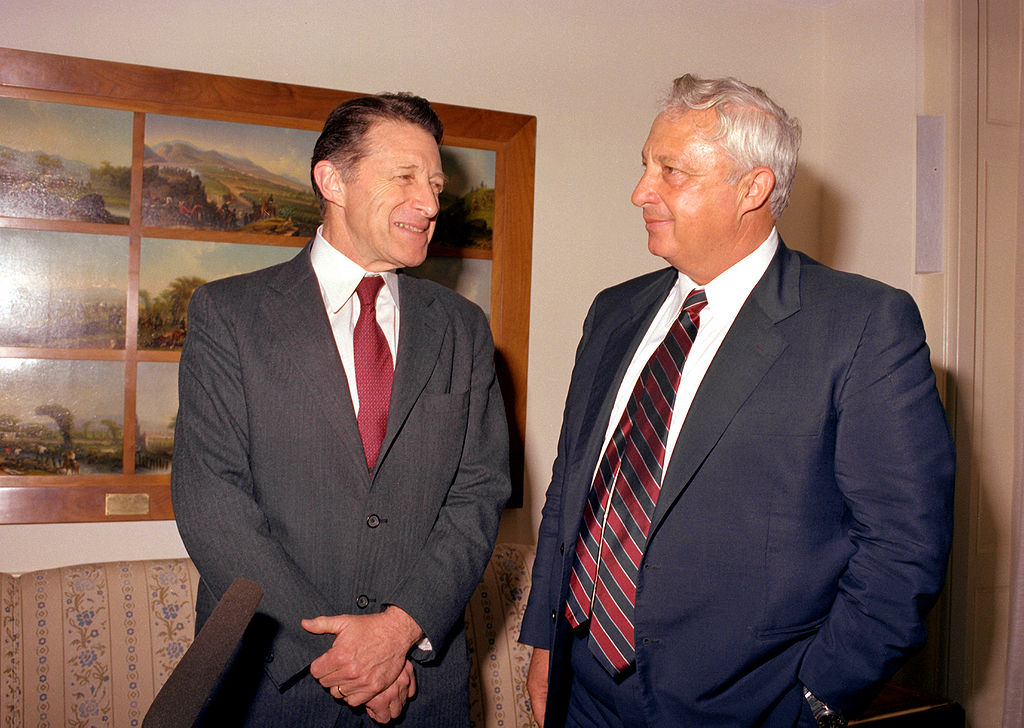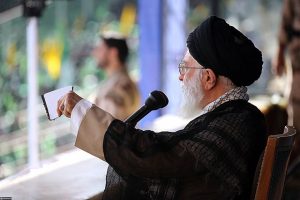by Jim Lobe
As readers of this blog know, I’m not a big fan of the Wall Street Journal’s editorial board, which pretty much defines neo-conservative foreign-policy orthodoxy and is probably the movement’s single-most influential and effective proponent in the elite U.S. media. If you accept certain of its assumptions — sometimes explicit, sometimes implicit — the editorials, columns, and op-eds the Journal produces usually make the most coherent case for a neo-conservative position, especially as regards anything having to do with Israel and its ruling Likud Party, as any other publication, including the Weekly Standard, the National Review, and Commentary’s Contentions blog. As tendentious and bizarre as these pieces often are, they also usually offer some degree of intellectual integrity.
In that respect, the “Wonderland” column published last Thursday by the Journal‘s deputy editor of the editorial page Daniel Henninger struck me as particularly lacking. I don’t read Henninger’s column very frequently; on foreign policy, he seems to be a lightweight compared to his colleague Bret Stephens, who writes the Tuesday “Global View” column. But I read this one, entitled “Rand Paul’s Reagan,” because its title raised a favorite interest of mine — the ongoing battle between the neo-con/aggressive nationalist and the paleo-con/libertarian wings of the Republican Party.
Of course, you should read the whole thing, but the part that really jumped out at me was his juxtaposition of the “Weinberger Doctrine” and his confident depiction of Ronald Reagan as a staunch and unflinching advocate of a hawkish foreign policy:
While there was never a formal Reagan Doctrine, Ronald Reagan himself said enough and did enough to know where he stood. In his 1985 State of the Union, Reagan said, “We cannot play innocents abroad in a world that’s not innocent.”
Ronald Reagan called the Soviet Union an “evil empire,” aligned his own policy toward Soviet Communism with the idea of “rollback,” stood at the Brandenburg Gate and cried, “Mr. Gorbachev, tear down this wall,” increased U.S. defense spending, deployed Pershing 2 ballistic missiles and cruise missiles in Europe amid world-wide protests in 1983, invaded Grenada the same year, and gave U.S. support to anticommunist movements in Afghanistan, Cambodia, Angola and Latin America—with many congressional Democrats in a towering rage of eight-year opposition to nearly all of it. The words Reagan used most to support all this were “freedom” and “democracy.” He ended four decades of Cold War.
Well, aside from the fact that Henninger seems to take great pride in U.S. support for such “anticommunist” and freedom-loving movements represented by the mujahadin (and future Taliban) in Afghanistan, the Khmer Rouge (de facto) in Cambodia, the witch-burning Jonas Savimbi in Angola, and the Somocista-led contras in Nicaragua (not to mention the murderous armies and security forces of El Salvador, Honduras, and Guatemala — the three main sources of all those children on the southern border now — in Central America), I find this litany of “where (Reagan) stood” in the context of any discussion of the Weinberger Doctrine quite remarkable for what it omits. More precisely, Henninger fails to devote a single word to the events that gave rise to Weinberger’s enunciation of the doctrine that bears his name: the disastrous deployment of U.S. marines at the Beirut airport and the Oct 23, 1983, bombing of their barracks in which 241 servicemen were killed.
Of course, what is relevant here was Reagan’s reaction. You would think from Henninger’s depiction of “The Gipper” that he not only would have shrugged off what was the worst one-day loss of life of U.S. servicemen since World War II. He would also have spared no effort to hunt down the perpetrators*, bombed the hell out of their suspected sponsors wherever they were to be found, and then quadrupled the number of troops deployed to Lebanon in order to demonstrate to all the world his determination to “stand” his ground in the face of terrorist threats and outrages, and defeat them.
In fact, however, Reagan did nothing of the kind. Two days after the disaster, his administration launched the invasion of tiny Grenada partly, no doubt, to divert the public’s attention from Beirut. Meanwhile, most of the surviving marines were immediately deployed offshore, and by February, they had been withdrawn entirely from Lebanon, albeit not before the USS New Jersey fired off dozens of VW Bug-sized shells at Druze and Syrian positions east of Beirut. (Neither is believed to have had anything to do with the bombing.) Weinberger, who had opposed the original deployment and had wanted to lay out the principal lessons that he thought should be learned from the debacle shortly after the withdrawal, waited until November 1984 to devote a speech to the subject. One year later, that same tough-guy Reagan, who, as Henninger recalls, warned against playing “innocents abroad,” authorized the arms-for-hostages deal that formed the basis of the Iran-Contra scandal …and then claimed that he had no idea that he was indeed trading arms for hostages. This is Henninger’s Reagan.
I should stress right away that, unlike both Paul and Henninger, I’m definitely not a defender of Ronald Reagan whose presidency, I believe, was an unmitigated disaster for the country (exceeded only by George W. Bush’s, of course), not to mention the many tens of thousands of innocent people who died or were killed by the application of the “Reagan Doctrine” in Central America, southern Africa (remember, Reagan’s support for apartheid South Africa), and Indochina. And, while I agree with Henninger that “Ron Paul’s Reagan” is not an entirely accurate rendition of the 40th president’s foreign policy, Henninger’s depiction is no less flawed. In fact, I believe it is fundamentally dishonest. After all, if you’re going to attack Paul’s central point about Reagan’s alleged adoption of the Weinberger Doctrine, the very least you can do is mention the events that gave rise to it: the ill-thought-out commitment of U.S. troops into a civil-war situation and their subsequent ignominious withdrawal. As noted by none other than Reagan’s own Secretary of the Navy, John Lehman (also a member of the 9/11 Commission), “There’s no question it [Reagan’s withdrawal] was a major cause of 9/11. We told the world that terrorism succeeds.” Of course, that particular Reagan obviously doesn’t exactly fit Henninger’s idealized and highly misleading version.
* One of the great ironies is that an alleged key planner of the 1983 barracks bombing, as well as other attacks against U.S. officials in that period, was an Iranian intelligence officer, Ali Reza Asgari, who, according to Kai Bird’s recent biography of Robert Ames (the CIA officer who was killed in the suicide bombing of the U.S. Embassy in Beirut six months before), was granted asylum in the U.S. during the George W. Bush administration in 2007 in exchange for sharing his knowledge of Iran’s nuclear program. According to Bird, Asgari has been living here under the CIA’s protection since his defection. You can find Augustus Richard Norton’s review of Bird’s book for LobeLog here.
Photo: Caspar Weinberger meeting in 1982 with then-Israeli Minister of Defense, Ariel Sharon Credit: public domain





Over the years the far right has built a mythology around their own fairy tales of the colossal warrior-god, Reagan. The way they go about it is to keep replacing real, historical facts with their own fantasies of the great feats of the great Reagan. Leave it up to this and a handful of other websites to once in a while tear down the sand castle of the rightwing mythology so badly that it leaves the rightwing believers completely speechless. As Mr. Lobe so wonderfully illustrates here, Reagan was in so many ways the opposite of what the right wishes him to have been. By today’s neocon standards Reagan was
1- a cut&runner, the way he packed up and ran away from Beirut after the cowardly slaughter of our servicemen in the barracks. As far as I’m concerned, he did the right thing instead of investing more of the American lives, getting us entrenched in a no-win situation just like the so many other instances in the quicksand that is Middle East. The troops should not have been there to begin with.
2- weak on terrorism, the way he said on the one hand “we don’t negotiate with terrorists” and the way in actuality he not only did just that, he had major partnerships with them, exchanging arms and favors for the hostages one after the other.
3- on the wrong side of history, the way he backed and supported Saddam Hussein, the way he practically invented Al Qaida and Talibans (except that he called them “the freedom fighters”), looked the other way as Pakistan and India built up their nuclear technology
4- a military lightweight since unlike his VP he didn’t serve in WWII, and his biggest military conquests were bombing Muammar Ghadafy’s tents at night and killing his infant daughter, and invading Grenada, a country as big as but not as well-armed as a subdivision in the Houston suburbs
5- a typical taxer and spender since he sat over the largest tax increase in the U.S. history as well as the biggest deficit spending spree by percentage of any American president which tripled the national debt
6- a scandalous president who was shielded by the media. Had it not been for the media his scandals would have dwarfed Watergate, the Monica Lewinsky affair and Ben Ghazi. To name a few, the Iran-Contra affair which very briefly showed the terrifying government within government reality, Nancy Reagan’s shenanigans and the decisions that were made with the advice of astrologers, his embarrassing on-air missteps such as threatening to bomb USSR as a joke, and the way his worsening dementia was covered up.
The list goes one. I applaud this website for continuing to counter WSJ’s running fantasies because that’s the only way the light of truth will stay lit.
Thank you Jim, you do us an honor with this post. What these right wing-nuts will write in the pages of revised history, seems to know no bounds. Preaching to the choir, as they say, and sadly, it’s the naive gullible novitiate that is reached with these redoes. Amazing what some will do for a paycheck.
Any discussion of the Reagan era and Iran is not complete without mentioning the “yellow ribbon.” You can say it became an early cornerstone of the Reagan foreign policy.
As a gesture of goodwill the Iranians timed the release of the hostages to coincide with Reagan’s inauguration bash. Not that the Iranians had any great love for Reagan. But their hatred of Jimmy Carter was so great they were in “the enemy of our enemy is our friend” mode.
So in January 1981 the yellow ribbon became the symbol of the returning hostages. Half the nation’s trees had yellow ribbons tied around them. The 1970’s hit “Tie a yellow ribbon” by Tony Orlando was the unofficial national anthem. If Reagan was looking for a boost to get the nation in good a mood and his presidency off on the right foot, the Iranians gave it to him in a gift box with a yellow ribbon tied on top.
The Soviet Union would have collapsed even if Reagan had spent many fewer hundreds of billions of dollars on “defence”.